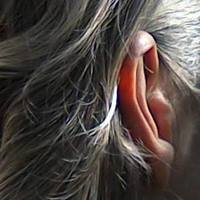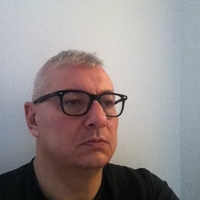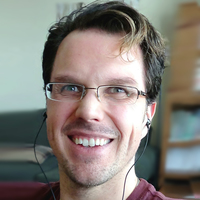Papers by Karmen Franinovic
Proceedings of the Thirteenth International Conference on Tangible, Embedded, and Embodied Interaction, 2019
In this paper, we discuss the opportunities and challenges of creating responsive environments wi... more In this paper, we discuss the opportunities and challenges of creating responsive environments with Electroactive Polymers (EAPs). Our previous research on tools and methods for EAPs enabled us to develop two public installations: SOLO and Electric Animal Plant. Going beyond the demonstration of EAPs, these projects explore the aesthetics and interactivity of such shape-changing materials. We explain actuating and sensing capabilities of EAPs in these works, and we reflect on the response of the participants to the installations.
Chapter in a book "Raw Flows: Fluid Mattering in Arts and Research", Editor R. ... more Chapter in a book "Raw Flows: Fluid Mattering in Arts and Research", Editor R. Kirschner, De Gruyter, 2017.
DOAJ (DOAJ: Directory of Open Access Journals), Jul 1, 2009
The gap between the design of the user experience and the design of the artifact 1. Prof. Ishii a... more The gap between the design of the user experience and the design of the artifact 1. Prof. Ishii asked this question to the panelist in the session called "Usability Evaluation Considered Harmful" at CHI2008, the conference of the Special Interest Group on Computer-Human Interaction of the Association for Computing Machinery. For more information visit http://sigchi.org/ 2.
Physical contexts, artifacts and materials have a big influence on the way children are enabled a... more Physical contexts, artifacts and materials have a big influence on the way children are enabled and encouraged in their play activities, especially in playgrounds. Designers and educators focus on formal and visual qualities of the playground, neglecting the potential of sound. Although sonic activities are common everyday phenomena in playgrounds and take an important role in children's development, there is a lack of knowledge on ways in which sound can be brought playgrounds. With the interdisciplinary project Sonic Playgrounds, we address this problem by developing methods, tools and guidelines which emphasize the role of sonic interactions on playgrounds. In this paper, we present two Sonic Playground studies: a workshop with interaction design students and a field study on a semi-public playground.

We advocate a new approach to the design of interactive and sonically augmented artifacts. It is ... more We advocate a new approach to the design of interactive and sonically augmented artifacts. It is aimed at enriching the context within which design takes place, while integrating the level of structured exploration that has been instrumental to formalizing design processes for nearly a century. The proposed process combines the systematic approach of basic design with exploratory studies within an existing everyday setting. The approach is particularly salient for auditory display in products, due to the relative lack of design examples and methods that exist for those working in this area to draw upon. We describe a study undertaken in domestic kitchen, a setting that has long been recognized as ripe with expressive, sonic interactions. The results of this contextual research have been used for the design of sonically-augmented lamps. We analyze the relevant results, and describe plans for integrating assessment methods.
The distinctive features of interactive sound installations in public space are considered, with ... more The distinctive features of interactive sound installations in public space are considered, with special attention to the rich, if undoubtedly difficult, environments in which they exist. It is argued that such environments, and the social contexts that they imply, are among the most valuable features of these works for the approach that we have adopted to creation as research practice. The discussion is articulated through case studies drawn from two of our installations, Recycled Soundscapes (2004) and Skyhooks (2006). Implications for the broader design of new musical instruments are presented.

Sensorimotor knowledge is acquired through physical interaction with our surroundings. Activities... more Sensorimotor knowledge is acquired through physical interaction with our surroundings. Activities such as drinking or biking must be learned through the body. Once this knowledge is acquired, such activities appear as intuitive, natural and automatic (Bargh 1999). Swiss philosopher and psychologist jean Piaget argued that sensorimotor learning is important for the early stages of child development (0–24 months) (Piaget 1954). In contrast to Piaget, Jerome Bruner argued that the acquisition of different types of knowledge (enactive, iconic and symbolic) is age-independent (Bruner 1966). He coined the term enactive learning in order to underline the importance of experience and environment in cognitive development. Thus, enactive learning happens largely in the early stages of human development when a child learns to walk or to drink, but also later in life. Without such knowledge, we would not be able to engage in new bodily experiences such as dancing, skiing or dough-making.

HAL (Le Centre pour la Communication Scientifique Directe), 1996
Despite being a promising and lively playground, sound design is not a discipline as solid and es... more Despite being a promising and lively playground, sound design is not a discipline as solid and established as visual or product design. We believe that the reason is to be found in the lack of design-oriented measurement and evaluation tools. The European project CLOSED (Closing the Loop Of Sound Evaluation and Design) aims at providing a functional-aesthetic sound measurement tool that can be profitably used by designers. At one end, this tool is linked with physical attributes of soundenhanced everyday objects; at the other end it relates to user emotional response. The measurement tool will be made of a set of easy-to-interpret indicators, which will be related to use in natural context, and it will be integrated in the product design process to facilitate the control of sonic aspects of objects, functionalities, and services encountered in everyday settings.

New Interfaces for Musical Expression, 2011
The perceived affordances of an everyday object guide its user toward habitual movements and expe... more The perceived affordances of an everyday object guide its user toward habitual movements and experiences. Physical actions that are not immediately associated with established body techniques often remain neglected. Can sound activate those potentials for action that remain latent in the physicality of an object? How can the exploration of underused and unusual bodily movements be fostered? This paper presents the Flo)(ps project, a series of interactive sounding glasses, which aim to foster social interaction by means of habitual and explorative sonic gestures within everyday contexts. We discuss the design process and the qualitative evaluation of collaborative and individual user experience. The results show that social interaction and personal use require different ways of transitioning from habitual to explorative gestures, and point toward possible solutions to be further explored.
An interactive system collects noise from a public place and transforms it into content for a pub... more An interactive system collects noise from a public place and transforms it into content for a public orchestration: the noise is split in specific sounds which are recomposed through sonic interface in a new soundscape. The SoundCam is the most visible part of the Recycling ...

We describe an emergent field of considerable relevance to the auditory display community-that of... more We describe an emergent field of considerable relevance to the auditory display community-that of sonic interaction design for everyday artifacts. It is positioned at the intersection of auditory display, product interaction design, and ubiquitous computing. We describe an exploration of this field that we have undertaken in a workshop setting, with an international mix of designers, students and researchers, aimed at investigating new roles for auditory display in everyday products, and possible methodologies for designing them. In this paper, we define sonic interaction design, describe the outcome of this workshop, which has been planned as the first in a series, and indicate future directions. We point to new research initiatives, including the European project CLOSED (Closing the Loop of Sound Evaluation and Design), which aims at providing new tools that are needed by designers working in this emerging field. 1 More information about the COST Action IC0601 on Sonic Interaction Design can be found at http://www.cost.esf.org/
De Gruyter eBooks, Dec 7, 2020
The first five months of the workpackage 4 of the CLOSED project were dedicated to reviewing the ... more The first five months of the workpackage 4 of the CLOSED project were dedicated to reviewing the scientific literature related to the perception of everyday sounds and to the theories of categories and categorization. The state of the art proposed below provides us with experimental results and theoretical assumptions which are the first bricks for a classification model of everyday sounds.

Amplifying Actions: Towards Enactive Sound Design Karmen Franinović Recently, artists and designe... more Amplifying Actions: Towards Enactive Sound Design Karmen Franinović Recently, artists and designers have begun to use digital technologies in order to stimulate bodily interaction, while scientists keep revealing new findings about sensorimotor contingencies, changing the way in which we understand human knowledge. However, implicit knowledge generated in artistic projects can become difficult to transfer and scientific research frequently remains isolated due to specific disciplinary languages and methodologies. By mutually enriching holistic creative approaches and highly specific scientific ways of working, this doctoral dissertation aims to set the foundation for Enactive Sound Design. It is focused on sound that engages sensorimotor experience that has been neglected within the existing design practices. The premise is that such a foundation can be best developed if grounded in transdisciplinary methods that bring together scientific and design approaches. These performance experiments have revealed that sonic feedback can support enactive learning. Finally, participatory workshops resulted in a number of novel methods focused on a holistic perspective fostered through a subjective experience of self-producing sound. They indicated the influence that such an approach may have on both artists and scientists in the future. The role of designer, as a scientific collaborator within psychological research and as a facilitator of participatory workshops, has been evaluated. Thus, this dissertation recommends a number of collaborative methods and strategies that can help designers to understand and reflectively create enactive sound objects. It is hoped that the examples of successful collaborations between designers and scientists presented in this thesis will encourage further projects and connections between different disciplines, with the final goal of creating a more engaging and a more aware sonic future.

AI & society, Sep 14, 2010
From the grotesque pavilions hidden in sixteenth century Italian gardens to the temporary structu... more From the grotesque pavilions hidden in sixteenth century Italian gardens to the temporary structures in public space in the 70s and recent digitally augmented environments, architectures of play have long been designed to engage explorative experiences. The uncertainty of play allows us to probe new behaviors, to poke into the boundaries of subjectivity and to interact with people, things and systems in unexpected and unfamiliar ways. In this essay, we explore how an interactive system, situated in public space, may foster explorative activities and enable the transformative power of play. Through the analysis of several computer-augmented architectures, we examine what interactive qualities might enhance the transformative power of play. Beginning with the Fun Palace, an early attempt to use cybernetics in order to encourage visitors to experiment with their habits, we move to contemporary projects including some of the author's own work. The latter takes the advantage of existing public locations in order to insert exploratory play into everyday life. Through analysis of these projects, we discuss whether such environments raise our responsibility toward others within our surroundings; whether they enable us to transform our own established behaviors; and whether they empower us to reclaim public space
The MIT Press eBooks, Mar 22, 2013
This chapter contains sections titled: 2.1 Introduction, 2.2 Sound as Malleable Material, 2.3 Soc... more This chapter contains sections titled: 2.1 Introduction, 2.2 Sound as Malleable Material, 2.3 Sociality and Spaciousness, 2.4 Responsiveness: The Temporal Shape of Sonic Interaction, 2.5 Responsiveness and Responsibility, Notes, References
Künstlerische Forschung. Ein Handbuch, 2015

Performance Research, 2020
Researchers and practitioners in the trading zone of art and science have been experimenting with... more Researchers and practitioners in the trading zone of art and science have been experimenting with human-made ecosystems involving a variety of biological, chemical, technical and aesthetic aspects. While microorganisms are always a part of such systems, most often they don't attract human attention. And if they are integrated into art and design projects, they are commonly put behind glass for safety or stability of the small ecosystems. However, in Biosphere 2, a large artificial glasshouse ecosystem built in the desert of Arizona, humans and microbes performed together with technical actors within the same environment. In this paper, we focus on Biosphere 2's ‘Mission One’ (1991–93), an ecological experiment in which eight humans, also called biospherians, together with other plant and animal species, were completely isolated in a large glasshouse from the biosphere of the Earth. Notwithstanding the lack of detailed information on specific microorganisms and their activity...











Uploads
Papers by Karmen Franinovic
Sonic Interaction Design gathers contributions from scholars, artists, and designers working at the intersections of fields ranging from electronic music to cognitive science. They offer both theoretical considerations of key themes and case studies of products and systems created for such contexts as mobile music, sensorimotor learning, rehabilitation, and gaming. The goal is not only to extend the existing research and pedagogical approaches to SID but also to foster domains of practice for sound designers, architects, interaction designers, media artists, product designers, and urban planners. Taken together, the chapters provide a foundation for a still-emerging field, affording a new generation of designers a fresh perspective on interactive sound as a situated and multisensory experience."
Contributors:
Federico Avanzini, Gerold Baier, Stephen Barrass, Olivier Bau, Karin Bijsterveld, Roberto Bresin, Stephen Brewster, Jeremy Coopersotck, Amalia De Gotzen, Stefano Delle Monache, Cumhur Erkut, George Essl, Karmen Franinović, Bruno L. Giordano, Antti Jylhä, Thomas Hermann, Daniel Hug, Johan Kildal, Stefan Krebs, Anatole Lecuyer, Wendy Mackay, David Merrill, Roderick Murray-Smith, Sile O’Modhrain, Pietro Polotti, Hayes Raffle, Michal Rinott, Davide Rocchesso, Antonio Rodà, Christopher Salter, Zack Settel, Stefania Serafin, Simone Spagnol, Jean Sreng, Patrick Susini, Atau Tanaka, Yon Visell, Mike Wezniewski, John Williamson
This thesis is concerned with ways in which interaction and technology can offer breaks from hectic urban flow, while supporting the awareness of the local surroundings and people in it. The designed projects explore ways in which technologically enhanced interaction between people and environment can impact our experience of place and our social interactions in the city. Through the creation of alternative audio-visual experiences of existing context, people are involved with new playful interactions within and around the surrounding urban context.
In this thesis, I define such alternative experiences as the Architecture of Subtraction, as gaps within and interruptions of the hectic urban flow, but not through the isolation from the surrounding urban context. As a practical exploration and an urban probe, the Recycled Soundscape project is discussed. It is an applied exploration and a platform for experimenting with the alternative sonic experience of urban space and social interactions emerging around it. The Architecture of Subtraction offers a conceptual framework on which the new urban landscape based on technologically enhanced spaces, is actively built through the interaction between people and their environment.